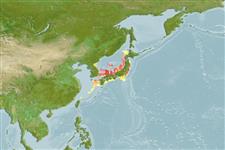Classification / Names
Common names | Synonyms | Catalog of Fishes (gen., sp.) | ITIS | CoL | WoRMS | Cloffa
Actinopterygii (ray-finned fishes) >
Perciformes (Perch-likes) >
Stichaeidae (Pricklebacks) > Lumpeninae
Etymology: Xenolumpenus: Name from Greek, Xeno (= strange), and Latinized Danish, lumpenus (type genus of the subfamily Lumpeninae), for the elongated pectoral, pelvic and anal fin rays.; longipterus: Name from Latin, longus for long and Latinized Greek pteron for wing; referring to the elongate pectoral fins.
Environment / Climate / Range
Ecology
Marine; benthopelagic; depth range 167 - 300 m (Ref. 84251). Temperate, preferred ?
Northwest Pacific: Japan.
Size / Weight / Age
Maturity: Lm ? range ? - ? cm
Max length : 11.5 cm SL (female)
Short description
Morphology | Morphometrics
Dorsal
spines
(total): 46 - 48;
Anal
spines: 2;
Anal
soft rays: 30;
Vertebrae: 52 - 54. This species is distinguished by having the following characters: DXLVI-XLVIII; A II,28-30; membrane extremely incised, rays elongate; 11 pectoral-fin rays, including 3 ventralmost rays free from others and the longest ray 36.5-40.2% SL; pelvic fin rays elongate, membrane well-incised, and rays unbranched; 2 mandibular pores; 1 or 2 large black blotches on pectoral fin; black ocellus on caudal fin (Ref. 84251).
The specimens have well-developed ovaries containing ca. 1.5 mm diameter eggs, suggesting the spawning of the species occurs in autumn (Ref. 84251).
Life cycle and mating behavior
Maturity | Reproduction | Spawning | Eggs | Fecundity | Larvae
Shinohara, G. and M. Yabe, 2009. A new genus and species of prickleback (Perciformes: Stichaeidae) from Japan. Ichthyol Res (2009)56:394-399. (Ref. 84251)
IUCN Red List Status (Ref. 115185)
CITES (Ref. 94142)
Not Evaluated
Threat to humans
Harmless
Human uses
More information
Common namesSynonymsMetabolismPredatorsEcotoxicologyReproductionMaturitySpawningFecundityEggsEgg development
Age/SizeGrowthLength-weightLength-lengthLength-frequenciesMorphometricsMorphologyLarvaeLarval dynamicsRecruitmentAbundance
ReferencesAquacultureAquaculture profileStrainsGeneticsAllele frequenciesHeritabilityDiseasesProcessingMass conversion
Tools
Special reports
Download XML
Internet sources
